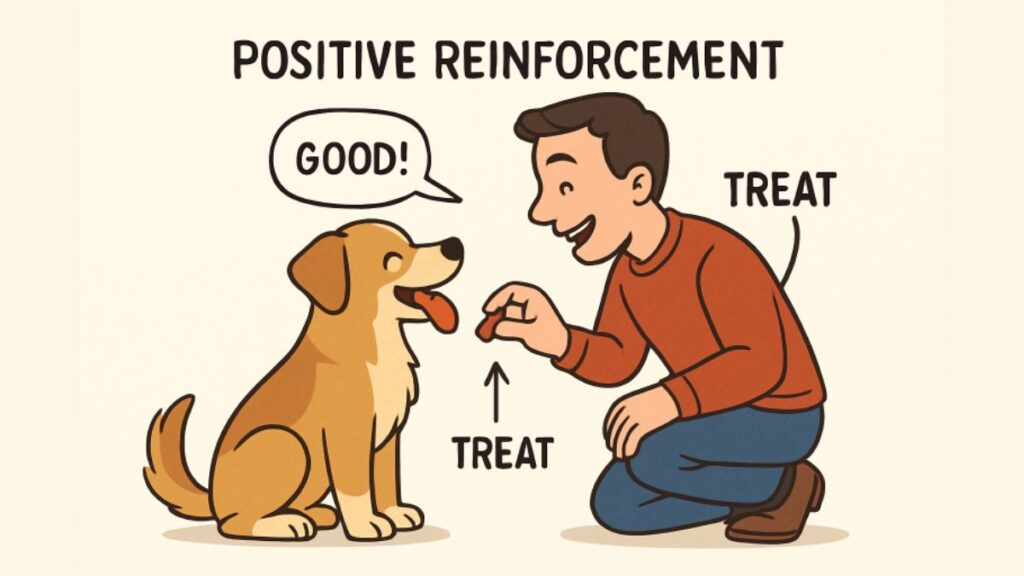Introduction
Dog training has transformed in recent years, shifting away from harsh, dominance-based practices and embracing reward-centered strategies. At the heart of this positive change lies the concept of positive reinforcement—an approach that teaches dogs good behavior and cultivates a deeper bond between pets and their families. Owners can create a trusting environment where learning thrives by focusing on what dogs do right and reinforcing those moments. For pet parents keen to embrace the most effective, humane techniques, Word Of Mouth Dog Training is a valuable resource for mastering the art and science of positive methods.
Modern positive reinforcement doesn’t simply reward for being nice; it is rooted in proven animal behavior science. This approach considers the dog’s emotional well-being, reduces stress, and creates motivation to learn—to obey and enjoy the process. Unlike older, forceful tactics, today’s trainers strive to build dogs’ confidence through trust rather than fear.
Moving to evidence-based methods has improved results in the home and formal training classes, supporting better long-term outcomes for families and their pets. Whether a puppy is learning to sit or an adult rescue dog is adjusting to a new environment, positive reinforcement lays the foundation for all future learning.
Many owners discover over time that positive reinforcement simplifies even complex training challenges and that consistency goes a long way toward lasting success. Embracing this method means you and your dog enjoy training together as a fun, rewarding experience.
At its core, positive reinforcement provides something pleasant immediately after your dog displays a desired behavior. This “something pleasant” might be a favorite treat, enthusiastic praise, a cheerful tone, or an exciting toy. The immediacy and consistency of the reward help the dog associate good behavior with excellent outcomes, increasing the chances the behavior will be repeated.
This humane method is in direct opposition to aversive training, which uses punishment or tools designed to frighten or cause discomfort. While punishment-based models may temporarily suppress unwanted behaviors, they often erode trust, increase anxiety, and can even trigger aggression. In contrast, positive reinforcement fosters learning by creating a safe environment and a clear pathway for the dog to succeed.
Benefits of Positive Reinforcement
- Enhanced Learning: Research consistently demonstrates that dogs taught using positive reinforcement learn faster and retain information better than those exposed to aversive methods. They are likelier to engage with their owners and participate enthusiastically in training sessions.
- Stronger Bond: Reward-based approaches nurture a closer and more trusting relationship between owner and dog. This bond fosters cooperation, making playtime and training less stressful and enjoyable.
- Reduced Behavioral Issues: Training that emphasizes positivity has been linked to fewer acts of aggression, less anxiety, and a lower likelihood of developing fear-driven behaviors. Dogs are less likely to react negatively in new or challenging situations because they have learned to trust their owners and express themselves confidently.
Common Myths and Misconceptions
Despite robust evidence supporting positive reinforcement, several persistent myths can confuse dog owners:
- Myth: Positive reinforcement means permissiveness or having “no rules.”
- Truth: Reward-based training requires structure, clear guidelines, and consistent expectations. Successful trainers set boundaries and communicate what behaviors are acceptable—rewarding only what is desired, not everything the dog does. This method isn’t about letting dogs “run wild,” but teaching appropriate behaviors with respect, clarity, and kindness.
- Myth: Dogs trained with treats will only obey when food is present.
- Truth: While food is a highly effective motivator, professional trainers also use praise, play, or affection as rewards. As a dog’s training progresses, rewards become more varied and less predictable, helping transfer good behavior to real-life situations without dependence on treats.
Practical Applications in Training
Implementing positive reinforcement in daily life and training sessions is straightforward but requires consistency:
- Identify Desired Behaviors: Be clear about what you want your dog to do—sitting politely, coming when called, or walking calmly on a leash.
- Choose Appropriate Rewards: Use incentives that genuinely motivate your dog. Squeeze cheese, tug-of-war games, or favorite chews can all spark enthusiasm for training.
- Timing is Key: Deliver the reward immediately following the correct behavior to cement the association. Dogs learn best when cause and effect are clear.
- Consistency: Regularly reinforce the right actions and be patient with setbacks. Every interaction is an opportunity to reward progress or gently redirect mistakes.
Positive reinforcement isn’t limited to formal obedience; it’s useful for house training, socialization, addressing reactivity, and more, making it the most versatile technique for shaping behavior.
Scientific Support and Research
A substantial body of research supports positive reinforcement’s efficacy and ethical advantages. Several studies, including those published in peer-reviewed journals, such as Scientific American, have documented that dogs trained with reward-based systems display lower rates of stress and problematic behaviors. These dogs also maintain training progress longer than those taught using force or fear. According to the findings of the Journal of Veterinary Behavior, humane training methods contribute to increased obedience, resilience, and overall well-being.
Transitioning from Aversive Methods
Shifting from traditional, punishment-based practices to positive reinforcement may take practice and patience—both for the human and the dog. Key steps include rewarding what the dog does right, replacing outdated strategies with new techniques, and seeking professional support if needed. Partnering with trainers specializing in positive reinforcement can make this transition smoother and give owners crucial skills to succeed. Resources such as those offered by major animal welfare organizations provide step-by-step guidance for families beginning this journey.
Conclusion
Positive reinforcement delivers a well-rounded, humane, and effective solution for every stage of canine behavior shaping. By rewarding the behaviors you want to see more of and building on trust, owners create better dogs and relationships. With patience, consistency, and the right resources, any dog and family can thrive using modern, science-backed training techniques for a happier and more harmonious home.






